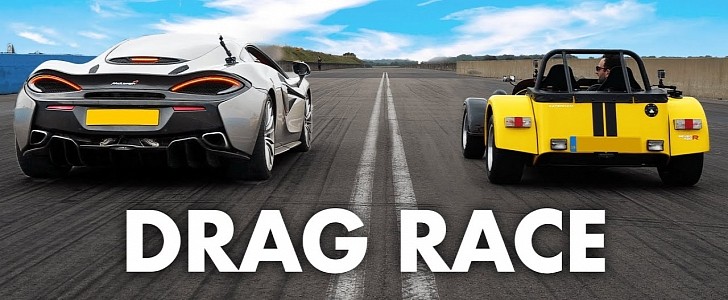Very few cars feel at ease when lining up next to a McLaren for a drag race, and pretty much all that do tend to have big V8s, a closed cabin, and a dual-clutch transmission.
The Caterham Seven 620R has none of that. It gets a two-liter four-cylinder supercharged Ford Duratec engine that produces 310 hp and 219 lb-ft (297 Nm) of maximum torque. All these figures are almost exactly half of what's written on the specs sheet of the McLaren 570GT, but the Caterham's saving grace is that the same can be said about its weight.
Put the small sports car on a scale and the display will show 1,345 lbs (610 kg). Do the same with the McLaren, and you'll notice that, at 3,086 lbs (1,400 kg), it's way more than double that. So, the Seven 620R has a clear power-to-weight advantage, but is that enough to instill confidence in the heart of its driver?
It shouldn't be because McLarens are known for two things: having a great launch despite the fact they're rear-wheel-drive-only (like the Caterham), and usually having more power than it says on the box. With that in mind, the power-to-weight advantage might be a little misleading.
Besides, the Caterham has one specific feature that is guaranteed to hurt its performance in a drag race: a six-speed manual transmission. Compare that to the seven-speed dual-clutch in the McLaren, and you know the yellow sports car will lose a few good milliseconds with every shift, and that's if the driver is good.
The issue becomes painfully obvious starting with the very first race. The 620R gets a good start and even goes in front, but come the first shift, it immediately drops back and loses any chance of winning the race. It's not that far, though, and if there's one car where you're guaranteed to have more fun than the other driver even when you're losing, it's definitely the Caterham.
Over on the other side, the 3.8-liter twin-turbo V8 engine performs just like you would expect it to, putting in one consistent run after another. It even manages to beat the open-top two-seater in the rolling race that took away its launch advantage, but the two drivers do manage to find one thing the Caterham is better at.
After trying a 0-100-0 mph (0-160-0 kph) race that the McLaren also won, they finally attempt a recreation of the famous moose test. The two cars go neck in neck for a while before the McLaren's much wider profile start hitting cones left and right. Finally, the little David is vindicated. It would have been a shame for the Caterham to come out of this as a complete loser.
Put the small sports car on a scale and the display will show 1,345 lbs (610 kg). Do the same with the McLaren, and you'll notice that, at 3,086 lbs (1,400 kg), it's way more than double that. So, the Seven 620R has a clear power-to-weight advantage, but is that enough to instill confidence in the heart of its driver?
It shouldn't be because McLarens are known for two things: having a great launch despite the fact they're rear-wheel-drive-only (like the Caterham), and usually having more power than it says on the box. With that in mind, the power-to-weight advantage might be a little misleading.
Besides, the Caterham has one specific feature that is guaranteed to hurt its performance in a drag race: a six-speed manual transmission. Compare that to the seven-speed dual-clutch in the McLaren, and you know the yellow sports car will lose a few good milliseconds with every shift, and that's if the driver is good.
The issue becomes painfully obvious starting with the very first race. The 620R gets a good start and even goes in front, but come the first shift, it immediately drops back and loses any chance of winning the race. It's not that far, though, and if there's one car where you're guaranteed to have more fun than the other driver even when you're losing, it's definitely the Caterham.
Over on the other side, the 3.8-liter twin-turbo V8 engine performs just like you would expect it to, putting in one consistent run after another. It even manages to beat the open-top two-seater in the rolling race that took away its launch advantage, but the two drivers do manage to find one thing the Caterham is better at.
After trying a 0-100-0 mph (0-160-0 kph) race that the McLaren also won, they finally attempt a recreation of the famous moose test. The two cars go neck in neck for a while before the McLaren's much wider profile start hitting cones left and right. Finally, the little David is vindicated. It would have been a shame for the Caterham to come out of this as a complete loser.











